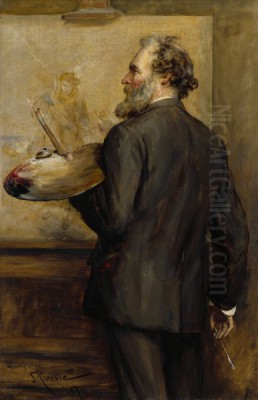
Thomas Faed stands as a significant figure in the landscape of 19th-century British art. A proud Scotsman, he dedicated much of his considerable talent to capturing the essence of his homeland, particularly the lives, joys, and sorrows of its ordinary people. His work, deeply rooted in the Victorian era's appreciation for narrative and sentiment, found immense popularity during his lifetime and continues to offer valuable insights into the social fabric and cultural identity of Scotland during a period of profound change. Faed's journey from rural Scotland to the heart of the London art establishment, marked by academic success and widespread acclaim, cemented his place as a leading genre painter of his time.
Early Life and Artistic Beginnings in Scotland
Thomas Faed was born on June 8, 1826, at Barlay Mill, near Gatehouse of Fleet in the historical county of Kirkcudbrightshire, Scotland. This region, Galloway, with its distinct landscapes and traditions, would remain a source of inspiration throughout his career. He hailed from a family with notable artistic inclinations; his father, James Faed, was an engineer and millwright, but his elder brothers, John Faed (1819-1902) and James Faed (1821-1911), both pursued successful careers as artists, John primarily as a painter and James as a renowned engraver. This familial environment likely nurtured Thomas's own artistic talents from an early age.
Following his father's death in 1842, Thomas moved to Edinburgh to live with his brother John. This move proved pivotal for his artistic development. He enrolled at the Board of Trustees' School of Design, known commonly as the Trustees' Academy. This institution was the crucible for many of Scotland's finest artists. Under the tutelage of masters like Sir William Allan and Thomas Duncan, Faed honed his skills in drawing and painting. He quickly demonstrated exceptional promise, winning prizes and recognition for his work.
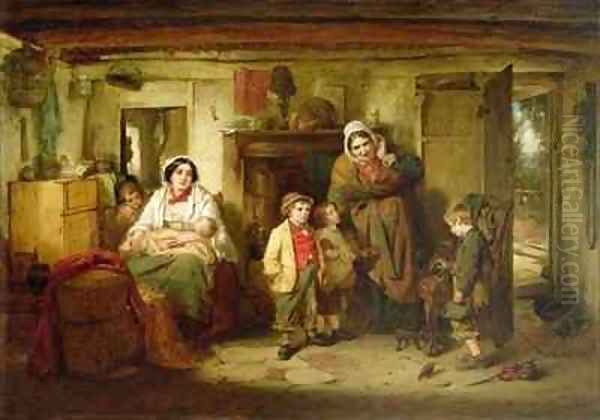
During his time in Edinburgh, Faed began to establish his reputation. In 1849, at the young age of 23, he was elected an Associate of the Royal Scottish Academy (ARSA), a significant honour that acknowledged his emerging talent and contribution to the Scottish art scene. His early works often depicted subjects drawn from Scottish literature and history, aligning with the prevailing tastes influenced by the legacy of Sir Walter Scott and the romantic interest in Scotland's past. Figures like Sir David Wilkie, the earlier master of Scottish genre painting, undoubtedly served as an important precedent for Faed.
The Move to London and Academic Acclaim
While Edinburgh provided a strong foundation, the gravitational pull of London, the undisputed centre of the British art world, proved irresistible for the ambitious young painter. In 1852, Thomas Faed relocated to London, following a path taken by many aspiring artists seeking wider recognition and patronage. This move marked a crucial turning point in his career, exposing him to a larger, more diverse audience and the competitive environment of the Royal Academy of Arts.
Faed's focus on relatable, often poignant scenes of Scottish domestic life struck a chord with the London public. His ability to tell a story through paint, combined with his technical skill, quickly garnered attention. His breakthrough came in 1855 with the exhibition of The Mitherless Bairn at the Royal Academy. This painting, depicting a destitute orphan child being welcomed into the humble cottage of a poor family, was an immediate sensation. Its blend of pathos, domestic virtue, and detailed realism resonated deeply with Victorian sensibilities, tapping into contemporary concerns about poverty, charity, and family.
The success of The Mitherless Bairn propelled Faed into the limelight. Engravings of the painting sold widely, making his imagery accessible to a broad public beyond the gallery walls. This success paved the way for further academic honours. In 1861, he was elected an Associate of the Royal Academy (ARA), and just three years later, in 1864, he achieved the prestigious status of full Royal Academician (RA). Membership in the Royal Academy was the pinnacle of artistic achievement in Britain, offering exhibition privileges, social standing, and significant professional validation. Faed remained an active and respected member for decades, finally retiring in 1893 due to failing eyesight.
Artistic Style and Dominant Themes
Thomas Faed's art is primarily characterized by its focus on genre painting – scenes of everyday life, particularly within the context of rural and often impoverished Scottish communities. His style is firmly rooted in realism, demonstrating meticulous attention to detail in rendering figures, clothing, interiors, and landscapes. He possessed a strong narrative impulse, constructing his compositions to tell clear, emotionally engaging stories that viewers could readily understand and connect with.
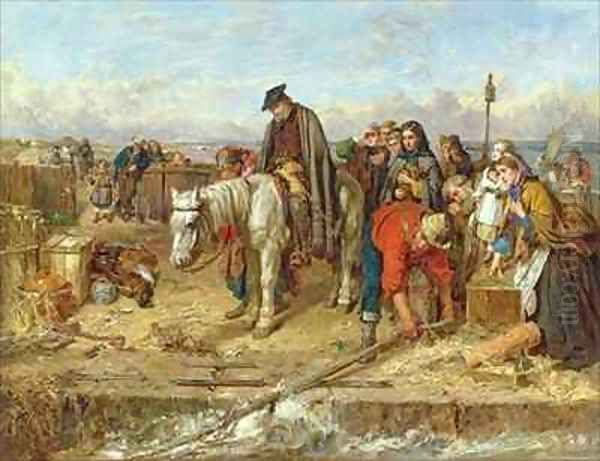
Sentiment and pathos are defining features of Faed's work. He frequently depicted scenes of hardship, loss, familial affection, childhood innocence, and quiet dignity in the face of adversity. His paintings often carry a moral or didactic undertone, celebrating virtues like compassion, resilience, piety, and the strength of family bonds, which were highly valued in Victorian society. While sometimes criticized later for excessive sentimentality, this emotional directness was key to his contemporary appeal. He aimed to touch the hearts of his viewers, evoking empathy for his subjects.
Scotland, its people, and its culture were the bedrock of his artistic identity. He drew heavily on his own background and observations of life in Galloway and the Highlands. Cottages interiors, crofters, fishermen, mothers and children, moments of departure and return – these were his recurrent motifs. His work contributed significantly to the popular imagery of Scotland in the 19th century, often presenting a somewhat romanticized yet deeply felt vision of traditional life, sometimes tinged with nostalgia for a disappearing world. He has been aptly compared to the poet Robert Burns in his ability to capture the spirit of his nation, Faed doing for Scottish painting what Burns did for Scottish song.
Key Techniques and Compositional Skills
Beyond the thematic content, Faed's success rested on his considerable technical proficiency. He was an accomplished draughtsman, underpinning his paintings with careful studies and well-structured compositions. His figures are solidly rendered, their poses and expressions effectively conveying the intended emotions and narrative roles. He paid close attention to the textures of materials – the rough weave of homespun cloth, the worn wood of furniture, the stone walls of cottages – adding to the realism and tactile quality of his scenes.
Faed demonstrated a masterful understanding of light and shadow, often employing a form of chiaroscuro to heighten drama and focus attention. Light frequently streams into dimly lit cottage interiors through windows or doorways, illuminating central figures or key narrative elements while leaving other areas in suggestive shadow. This manipulation of light contributes significantly to the mood and atmosphere of his paintings, enhancing their emotional impact. Think of the way light falls in works by Dutch masters like Rembrandt or Johannes Vermeer, adapted here for Victorian narrative purposes.
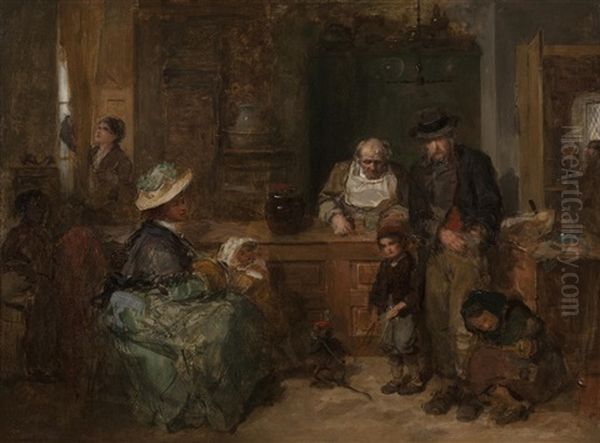
His compositions are typically carefully staged, arranging figures and objects to guide the viewer's eye and unfold the story logically. He often used enclosed spaces, like cottage interiors, to create a sense of intimacy and focus attention on the human drama unfolding within. Even in works with outdoor settings, the landscape often serves as a backdrop or symbolic element reinforcing the central human theme, rather than being the primary subject itself, distinguishing him from pure landscape painters like his contemporary Horatio McCulloch.
Major Works and Their Significance
Several of Thomas Faed's paintings achieved iconic status and exemplify his artistic concerns.
The Mitherless Bairn (1855): As mentioned, this was his breakthrough work. Exhibited at the Royal Academy, it depicts a barefoot orphan child, clutching a small bundle, standing hesitantly in the doorway of a humble cottage. Inside, a family group looks on with expressions of compassion and concern, the mother figure extending a welcoming gesture. The painting’s power lies in its direct appeal to empathy, its depiction of Christian charity among the poor, and its detailed rendering of the cottage interior. It cemented Faed's reputation as a master of domestic pathos.
The Last of the Clan (1865): This is arguably Faed's most famous work dealing with the theme of emigration, a direct consequence of the Highland Clearances. It shows a group of Highlanders gathered on a quayside, waiting to board a ship that will take them away from their ancestral lands. The central figures are an elderly patriarch, seated and looking despondent, surrounded by his family – women weeping, children looking uncertain. The painting captures the profound sense of loss, displacement, and the breaking of ancient ties that characterized this traumatic period in Scottish history. It is a powerful visual statement on cultural disruption and forced migration.
From Hand to Mouth (1879): This work tackles the theme of urban poverty, showing a struggling family, possibly recent arrivals from the countryside, trying to make a living. It reflects the harsh realities faced by many during the industrial revolution and highlights Faed's ongoing concern with the lives of the less fortunate, extending his gaze beyond purely rural settings.
Highland Mary (c. 1850s): This title likely refers to paintings inspired by the figure associated with Robert Burns's famous poems. Such works tap into the romanticized image of the Highlands and its association with Scotland's national poet, blending literary inspiration with Faed's characteristic style.
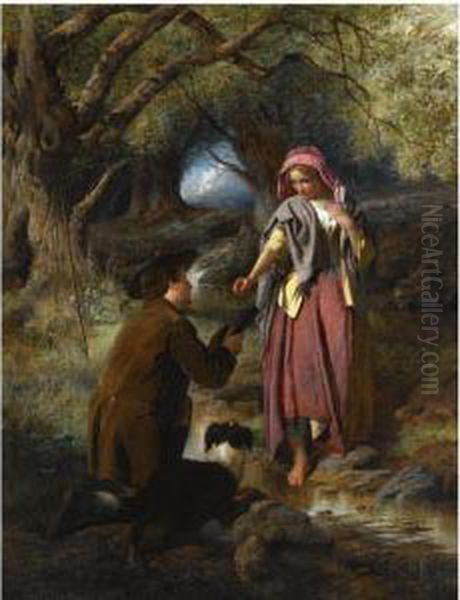
Worn Out (1868): Depicting an exhausted father who has fallen asleep by the bedside of his sick child, this painting is another example of Faed's focus on familial love and hardship. It highlights the theme of parental devotion and sacrifice, rendered with touching realism.
Sir Walter Scott and his Friends at Abbotsford (exhibited 1849): An earlier work, this large group portrait demonstrates Faed's ability to handle complex compositions and historical subjects. It shows the celebrated author surrounded by prominent literary and intellectual figures of his day, reflecting the cultural reverence for Scott in Scotland.
These works, among many others like The Reapers, Faults on Both Sides, and A Wee Bit Fractious, showcase the range of Faed's subject matter while consistently reflecting his core style and thematic interests.
Context: Victorian Scotland and the Highland Clearances
To fully appreciate Thomas Faed's work, it is essential to understand the historical context of 19th-century Scotland. This was a period of immense social and economic transformation. While the Lowlands experienced industrialization and urbanization, the Highlands underwent the traumatic upheaval of the Clearances. Landowners systematically evicted tenant farmers (crofters) from their traditional lands, often brutally, to make way for more profitable large-scale sheep farming.
This policy led to widespread poverty, social unrest, and mass emigration, primarily to Canada, the United States, and Australia. The Highland Clearances resulted in the destruction of a traditional way of life based on the clan system and subsistence agriculture, leaving deep scars on the Scottish psyche. Faed's paintings, particularly The Last of the Clan, directly engage with this painful history, capturing the sorrow and sense of loss associated with forced departure from one's homeland. His work provided a visual counterpart to the poems and songs lamenting these events.
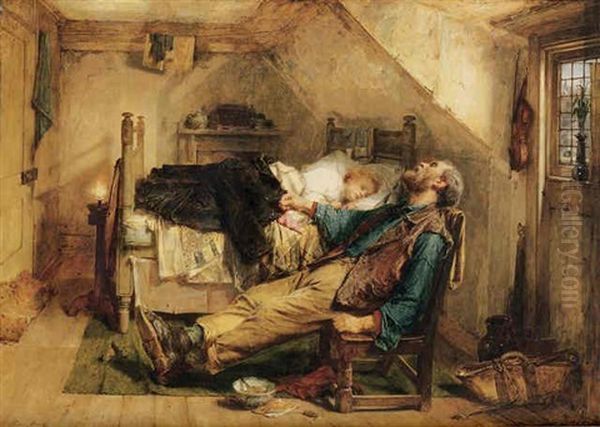
More broadly, Faed worked within the context of Victorian Britain. This era saw a huge appetite for narrative art, paintings that told stories, conveyed moral lessons, or evoked strong emotions. The rise of a prosperous middle class created a new market for art, particularly genre scenes depicting domestic life, childhood, and relatable human experiences. The Royal Academy exhibitions were major social events, and the widespread dissemination of art through engravings made popular images accessible to an unprecedented degree. Faed's success was partly due to his ability to perfectly meet the tastes and expectations of this Victorian audience, while grounding his work in authentic Scottish experience. His contemporaries in England, like William Powell Frith capturing panoramic views of modern life (Derby Day, The Railway Station) or Sir John Everett Millais moving from Pre-Raphaelitism to popular sentimental subjects, operated within a similar cultural milieu.
Faed and His Contemporaries
Thomas Faed was part of a vibrant artistic community, both in Scotland and London. His most immediate artistic connections were his brothers. John Faed achieved success as a painter of historical scenes, literary subjects (including Shakespearean themes), and portraits. James Faed became one of the most respected engravers of his time, translating the paintings of Thomas and others into prints, which greatly amplified their reach and popularity. The Faed brothers formed a notable artistic dynasty.
In Scotland, Faed's work can be seen in relation to Sir David Wilkie (1785-1841), the pioneering figure of Scottish genre painting whose depictions of rural life set a precedent. While Faed followed Wilkie's thematic path, his style reflected later Victorian sensibilities. Other Scottish contemporaries included Erskine Nicol (1825-1904), who also painted scenes of Scottish and Irish peasant life, often with a humorous or anecdotal bent; Sir George Harvey (1806-1876), known for historical scenes and depictions of Covenanter history; and the landscape painter Horatio McCulloch (1805-1867), who captured the grandeur of the Scottish Highlands. William McTaggart (1835-1910), a slightly younger contemporary, moved towards a more impressionistic style, particularly in his seascapes, representing a different direction in Scottish painting later in the century.
In London, through his involvement with the Royal Academy, Faed would have known and exhibited alongside the leading figures of the English art world. These included the aforementioned Millais and Frith, as well as Sir Edwin Landseer (famous for his animal paintings, including Scottish subjects like The Monarch of the Glen), Luke Fildes (known for social realist works like Applicants for Admission to a Casual Ward), and many others who shaped the diverse landscape of Victorian art. Faed held his own in this competitive environment, carving out a distinct niche with his focus on Scottish themes.
Reception, Criticism, and Enduring Appeal
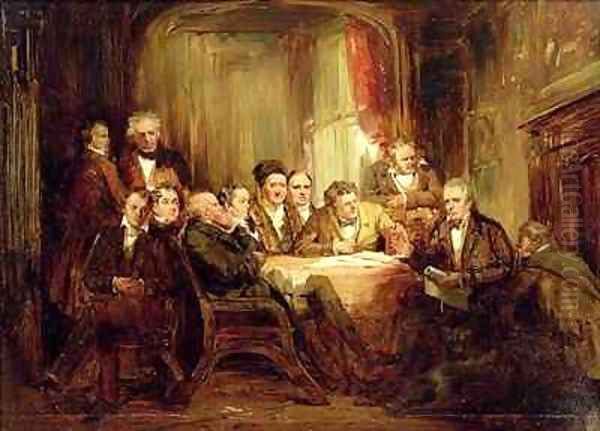
During his lifetime, Thomas Faed enjoyed enormous popularity. His paintings were eagerly anticipated at the Royal Academy exhibitions, and the demand for engravings of his work was immense. He achieved financial success and critical acclaim, becoming one of the most celebrated painters of his generation. His ability to connect emotionally with a wide audience was undeniable. His work was seen as embodying national character and virtuous sentiment.
However, his art was not without its critics, particularly as artistic tastes began to shift towards the end of the 19th century and into the 20th. The very qualities that made him popular – the overt sentimentality, the detailed narrative, the focus on anecdote – came to be seen by some as old-fashioned or even manipulative. The term "pot-boiler" was sometimes applied, suggesting his work was commercially driven and lacked deeper artistic innovation. An article in the Australian Daily Telegraph, for instance, characterized his work as typifying the "pot-boiling" school, laden with nostalgia and emotion.
Despite these criticisms, Faed's work has retained its appeal and historical importance. His paintings offer invaluable visual records of Scottish rural life, costume, and social customs during the 19th century. They provide poignant commentary on significant historical events like the Highland Clearances. Furthermore, his technical skill as a painter – his draughtsmanship, composition, and handling of light – remains evident. Today, his work is appreciated not just for its narrative content but also for its artistic merit and its crucial role in the story of Scottish art and Victorian culture. Museums across the UK and internationally hold his works, testifying to his lasting significance.
Later Life and Legacy
Thomas Faed continued to paint and exhibit regularly throughout the 1870s and 1880s, though perhaps without achieving the sensational impact of his earlier successes like The Mitherless Bairn or The Last of the Clan. He remained a respected figure within the Royal Academy. In 1861, he married Jane Matthieson, and they had several children.
His active painting career largely came to an end due to failing eyesight. In 1893, he took the status of Retired Royal Academician. He spent his final years in London, where he had lived and worked for over four decades. Thomas Faed died on August 17, 1900, at his home in St John's Wood, London.
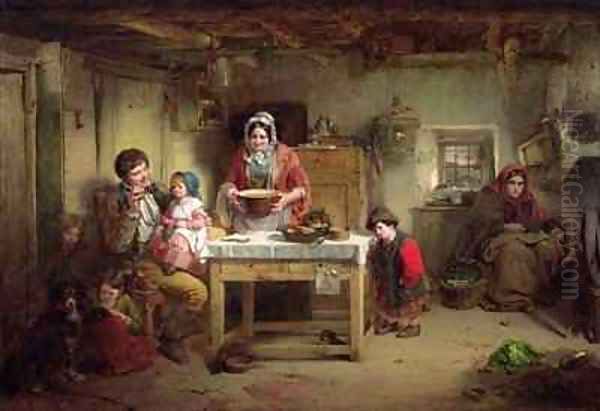
Thomas Faed's legacy is that of a master storyteller in paint, an artist who captured the heart of Scotland for a Victorian audience. He translated the specific experiences of Scottish rural communities – their hardships, affections, traditions, and the trauma of displacement – into universally relatable narratives. While subject to the changing tides of critical fashion, his work endures as a significant contribution to British art, offering a rich, detailed, and emotionally resonant window onto the world of 19th-century Scotland. He remains a key figure for understanding both Victorian genre painting and the visual representation of Scottish identity.
Conclusion
Thomas Faed occupies a vital place in the history of British art, particularly as a chronicler of 19th-century Scottish life. From his beginnings in rural Galloway and education in Edinburgh to his rise through the ranks of the Royal Academy in London, his career was marked by popular acclaim and artistic dedication. Through works like The Mitherless Bairn and The Last of the Clan, he captured the pathos and resilience of ordinary people, addressing themes of family, poverty, emigration, and cultural identity with a realism and sentiment that deeply resonated with his Victorian contemporaries. Although sometimes criticized for sentimentality, his technical skill, narrative power, and importance as a visual historian of Scotland ensure his enduring significance. His paintings continue to engage viewers, offering both artistic pleasure and profound insight into a pivotal era in Scottish and British history.